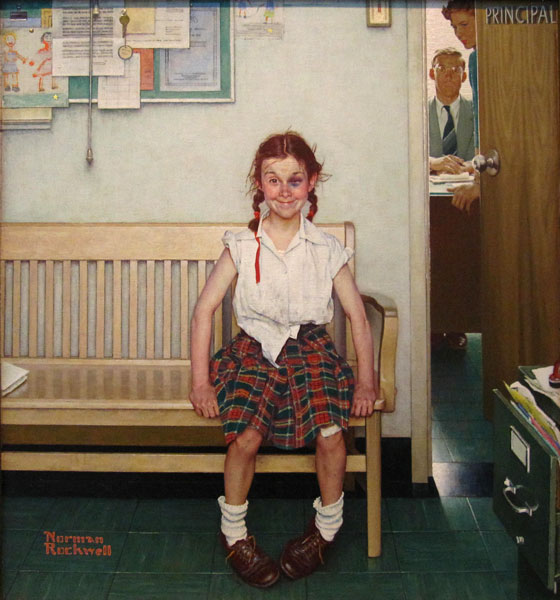This article discussed the new book, “American Mirror- The Life and Art of Norman Rockwell” by Deborah Solomon, an author and frequent contributor to the New York Times (who by the way, is going to be speaking at a Macaulay event that you can RSVP for here.) Though Norman Rockwell’s life has been discussed greatly, from critics, reviews, and his own autobiography, few know much about the true Rockwell. In the book, Solomon discusses the life and art of the famous American painter and tries to make him applicable in the modern era. 
Growing up, I loved flipping through books of Rockwell’s art. His works, just make the viewer smile and the idealized portraits of the American life was all that I could have hoped for in my own. My personal favorite is “The Shiner.” Norman Rockwell has carved out a space in American culture, making him as American as apple pie and Uncle Sam. Though growing up, I never knew much about his life, it was interesting to read about some of the struggles he faced. Extremely isolated, depressed, and perhaps a repressed homosexual? The book identifies some of Norman Rockwell’s personal maladies and how they may have effected his artwork and what he produced. The article says “His emotional and physical closeness to men is evident in the large number of his pictures most comfortably viewing a male world. But he also masked his inner life of self-doubt and psychic pain by painting their opposite…” If so, the many paintings that many Americans idealize and that much of American culture is just a cheap veneer, covering broken insides. I think that its always important to look at the historical and cultural context behind art because its nearly impossible to no be influenced by your environment. What were the consequences of portraying an ideal America while the reality didn’t match it? Also, as a man who lived through both world wars, the Great Depression, and many huge turning points in America’s history, how does his art show what he felt? In his large body of work (over 4,000 pieces) where does his point of view come in? What were the effects of masking so much pain with the ideal life that people wanted to see from Norman Rockwell?
Solomon also explores Rockwell’s art, looking at it through a post-modern lens, and identifying some of his work as Abstract Expressionism. At first, Rockwell’s straight forward portrait-esque work hardly seems comparable to the works of Willem de Kooning and Jackson Pollock, but as the article mentions, Rockwell creates his own version of Pollock in “The Connoisseur” . She also notes his art influences such as Renaissance artists and painters like Michelangelo and Da Vinci in his work. Drawing an idea of where an artist is coming from often sheds light on their point of view and thought process in creating works. Sadly, I don’t believe many Americans know the true Normal Rockwell. An individual so associated with the perfect American life actually suffered greatly for his art. Perhaps it was a mask to cover it up, a tool for coping, or perhaps it only made it worse. Either way, there is no doubt that Rockwell’s art continues to be influential on American culture and the American identity. Though we may never truly know the mind of Normal Rockwell, Deborah Solomon’s book helps to bring new insight and prompts readers to think and question the life of this all-American man.
You can peruse through some of his many works here and don’t forget to register for the Macaulay event!
Works Cited:
http://www.nytimes.com/2013/11/01/books/american-mirror-about-norman-rockwell-by-deborah-solomon.html?pagewanted=2&ref=design
http://www.nrm.org/


I have seen a great deal of Norman Rockwell’s work over the years. From museums, television, and school. He is an essential part of American history and played an important role in how America came to be. It is interesting that I never really knew anything about him personally. It is surprising that a person who goes through so much inner turmoil can create a work of art that emphasizes so much joy an hope. Rockwell was alive during some of the nation’s toughest moments and he was able to capture so much of the American ideology and its changes for the future. This article I found has some information about Rockwell’s process, he actually photographed the scenes he painted first, to get a natural feel. The article also talks about a museum where you could see how his paintings came to be.
http://www.nytimes.com/2010/12/10/arts/design/10rockwell.html?ref=normanrockwell
I liked you reviewing this book because I don’t usually like books written about other people. However, I do know who Rockwell is and in an article I read in September, he has quite the number of fans. “Rockwell collectors include the filmmakers George Lucas and Steven Spielberg, as well as the businessman Ross Perot and Alice Walton, the Walmart heiress.” Because of this, I think this book will be really interesting to read. Thanks for your great article.
http://www.nytimes.com/2013/09/19/arts/design/norman-rockwells-america-newly-up-for-bid.html?pagewanted=2&_r=0